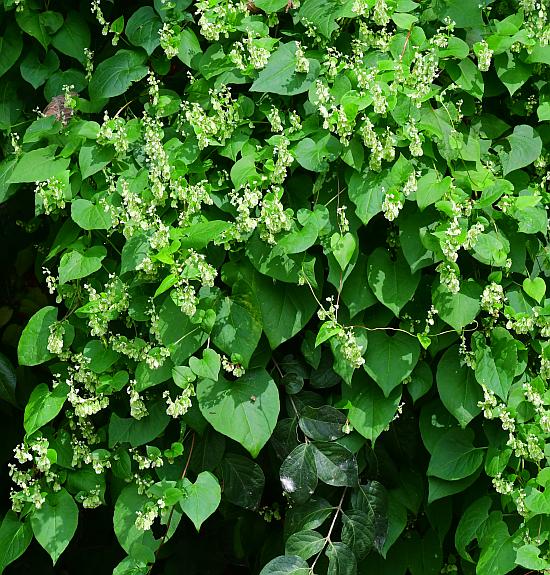Fallopia scandens (L.) Holub
False Buckwheat

Native
CC = 3
CW = 0
MOC = 74
© SRTurner
Fallopia scandens (L.) HolubFalse Buckwheat | |
 |
Native CC = 3 CW = 0 MOC = 74 |
© SRTurner |
|
Family - Polygonaceae Habit - Annual or perennial forb, with fibrous roots, sometimes taprooted, usually climbing on adjacent vegetation. Stems - Twining, sprawling or climbing, to 5 m, twisting with age, often slightly ribbed, typically becoming reddish in sun, branching, sparsely to moderately pubescent with minute, downward-curved hairs, occasionally also somewhat mealy. Ocreae 1-6 mm long, oblique at the tip, the surface glabrous or minutely roughened, tan to greenish brown. Leaves - Alternate, simple, petiolate. Petioles to 5 cm long, slightly scabrous from tuberculate ridges. Blades 1-14 cm long, 0.8-7.0 cm wide, usually heart-shaped, usually cordate at the base, with the parallel or slightly spreading basal lobes rounded at the tips, the upper surface glabrous, the undersurface minutely roughened and often somewhat mealy, also gland-dotted.
Inflorescence - Axillary , spikelike racemes, the flowers 3-6 per fascicle, the flower stalks 3-8 mm long, winged or not, jointed above the midpoint.
Flowers - Perfect. Tepals 3-5 mm long at flowering, sometimes becoming enlarged to 4-10 mm at fruiting, those of the inner whorl mostly elliptic, those of the outer whorl obovate, angled to tapered and decurrent or not along the stalklike base, glabrous or sparsely and minutely hairy, white, greenish white or pinkish-tinged, the outer 3 tepals with dorsal wings to 1-3 mm wide at fruiting. Styles very short, fused most of their length, the stigmas capitate, entire along the margins. Perianth segments persistent in fruit and giving a winged appearance. Stamens 10, adnate at base of perianth segments. Filaments white, glabrous, 0.7 mm long. Anthers white, bi-lobed, 0.2 mm long. Ovary green, 3-sided, glabrous. Stigma capitate, green.
Fruits - Achenes 3-sided, 2-6 mm long, the surface shiny, smooth, dark brown to black, enclosed in persistent perianth.
Flowering - July - November. Habitat - Forest openings, savannas, glades, streambanks, pond margins, sloughs, seeps, ledges and tops of bluffs, crop fields, fencerows, ditches, quarries, railroads, roadsides, open disturbed areas. Origin - Native to the U.S. Lookalikes - Other species within the genus, especially F. convolvulus and F. dumetorum. These are somewhat less common in Missouri. Other info. - This climbing plant is common across most of Missouri and the eastern U.S., and also ranges into Canada. It grows vigorously and will sometimes cover adjacent vegetation with masses of vines. It is easily recognized by its heart-shaped leaves, stems with small ocreae, and distinctive flowers and fruits. However, lookalikes are reasonably common and appear very similar. In F. scandens, the leaf auricles are rounded and the achenes are shiny. F. convolvulus has dull achenes and F. dumetorum typically has pointed leaf auricles. Photographs taken in the Crowleys Ridge Conservation Area, Stoddard County, MO., 6-14-03, and in the Ozark National Scenic Riverways, Shannon County, MO., 9-15-03 (DETenaglia); also along the Katy Trail near Dutzow, Warren County, MO, 9-16-2011, at Tyson County Park, St. Louis County, MO, 8-31-2018, and along the Katy Trail near Marthasville, Warren County, MO, 9-15-2020 and 9-15-2024 (SRTurner). |